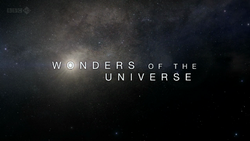Wonders of the Universe
| Wonders of the Universe | |
|---|---|
 |
|
| Genre | Documentary series |
| Directed by | Chris Holt |
| Presented by | Professor Brian Cox |
| Theme music composer | Sheridan Tongue |
| Country of origin | United Kingdom |
| Original language(s) | English |
| No. of series | 1 |
| No. of episodes | 4 |
| Production | |
| Executive producer(s) | Jonathan Renouf |
| Running time | 59 minutes |
| Release | |
| Original network |
BBC Two BBC HD |
| Picture format |
SD: 576i 16:9 HD: 1080i |
| Audio format | SD: Stereo HD: Stereo |
| Original release | 6 March – 27 March 2011 |
| Chronology | |
| Preceded by | Wonders of the Solar System (2010) |
| Followed by | Wonders of Life (2013) |
| External links | |
| Website | |
Wonders of the Universe is a 2011 television series produced by the BBC, Discovery Channel, and Science Channel, hosted by physicist Professor Brian Cox. Wonders of the Universe was first broadcast in the United Kingdom on BBC Two from 6 March 2011. The series comprises four episodes, each of which focuses on an aspect of the universe and features a 'wonder' relevant to the theme. It follows on from Cox's 2010 series for the BBC, Wonders of the Solar System. An accompanying book with the same title was also published.
We can trace our ancestry back hundreds of thousands of years to the dawn of humankind. But in reality, our story extends far, further back in time. Our story starts with the beginning of the universe. It began 13.7 billion years ago, and today, it's filled with over a hundred billion galaxies, each containing hundreds of billions of stars.
In this series, I want to tell that story, because ultimately, we are part of the universe, so its story is our story.
In the first episode, Cox considers the fundamental nature of time while pondering the ruins at Chankillo in Peru. He explores the familiarly brief cycles of time that define the lives of humans on Earth (such as days, months, and years), and compares them to the cycles of time on a cosmically universal scale (such as our solar system's 250 million year circuit around the Milky Way). At the Perito Moreno Glacier Cox introduces the Arrow of Time and the idea of irreversible change using GRB 090423 as an remnant of the early Stelliferous Era. At Kolmanskop he further discusses the thermodynamic arrow of time citing the inevitable increase of entropy, and stellar evolution. He continues by looking at Proxima Centauri, a slow burning red dwarf, and concludes the show over the Skeleton Coast of the Namib Desert, using the wreck of the Eduard Bohlen to illustrate the inevitable heat death of the universe.
...
Wikipedia
